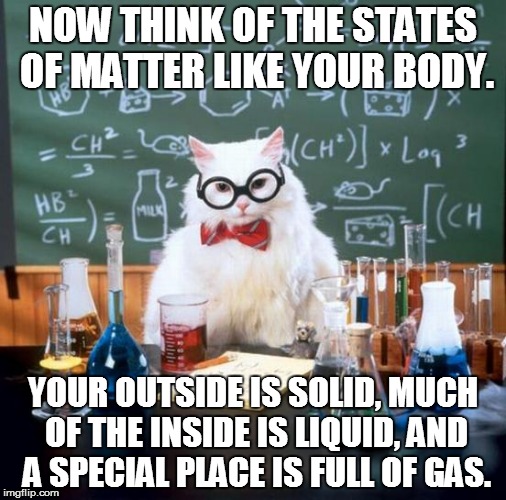11 chem, week 15 - Mom, the Atmosphere is Gassy Again!
Hey y'all, it's Liam again. Let's go straight into it!
 |
| Science Cat getting down to business |
First off, I learned about the "ideal gas laws", so called because they apply perfectly to ideal gases (any gas made of particles that only have perfectly elastic collisions). However, most gases behave (with a small amount of error) like ideal gases, so scientists are able to apply these laws to most everyday gases as well. Here they are:
- Robert Boyle's Law: The pressure inside a gas-containing container increases when the size of the container decreases. This relationship changes at the same rate for every gas
- Jacques Charles' Law: The hotter a gas, the larger its volume
- Amedeo Avogadro's Law: As the number of gas molecules inside a container is increased, so too is its volume
These relationships are very important later on, as is the kinetic theory:
- Kinetic Theory Assumptions:
- Gas particles are treated as hard, perfect spheres with insignificant volume
- Particles are constantly moving in rapid, constant, random, straight-line paths
- All collisions between particles is perfectly elastic
After that was research on different types of pressure and different ways of measuring said pressures. Gas pressure is a pressure resulting from the force that this gas exerts per unit of surface area on an object. A vacuum is an area with no particles and hence no pressure at all. (Fun fact: while space is often called a vacuum, it is not a true vacuum as there are still a tiny number of particles in every square meter of space) As we know, we have an atmosphere, and although we can't actively feel it, it exerts a pressure on everything. Atmospheric pressure results from the collisions of atoms and molecules in the air with other objects.
Now obviously we must have a way to measure this pressure, and it is called a barometer. It works by having a foot-long tube attached to a basin filled with mercury, with the tube being a vacuum so as to not impede the mercury when it rises. Speaking of which, the mercury rises when there is more atmospheric pressure as there is more "atmosphere", so to speak, pressing down on the basin, thus pushing the mercury up the tube. This creates equilibrium between the internal and external pressures, and is a fairly accurate way of measuring atmospheric pressure.
Finally, there are several different units used when talking about pressures. First, every unit has a Standard Pressure (STP) that is the measure (in that unit) of standard atmospheric pressure. The most common units of pressure are listed below:
- mmHg: also called Torr, this is a measure of atmospheric pressure within a mercury barometer (STP is 760)
- kPa (kilopascals): the SI standard of atmospheric pressure, this is measured in thousands of pascals (STP is 101.3)
- Atmospheres: commonly shortened to ATM (STP is 1)
- PSI: pounds per square inch (STP is ~14.6959)
 |
| Science Cat getting a bit naughty here |
I was then bombarded with three (3!) whole new variables to deal with in equations: temperature (T), volume (V), and pressure (P). Along with these variable are three (3!) whole new equations, and one (1!) extra-fun equation that puts the other three together. The first three equations are as follows:
- Boyle's Law: + Pressure --> - Volume (P1*V1=P2*V2)
- Gay-Lussac's Law: + Temperature --> + Pressure (P1/T1=P2/T2))
- Charles' Law: + Temperature --> + Volume (V1/T1=V2/T2)
And the combined law:
- (P1V1)/T1 = (P2V2)/T2
There were a couple video examples of these different laws in action (Boyle's Law, Charles' Law, and Gay-Lussac's Law), followed by Dalton's law of partial pressures (Pn = P1 + P2 + P3 … Pn) and the difference between diffusion (particles diffuse from high concentration to low concentration until they are in equilibrium) and effusion (gases escape through tiny holes in their container).
Remember all that stuff about ideal gases? Well, now that we have our combined gas law, we can use it to create the Ideal Gas Law! Avogadro's Hypothesis states that if both gases have the same volume at the same pressure and temperature, they will have the same number of moles. Therefore, these steps should get you to the Ideal Gas Law:
- (P1V1)/T1 = (P2V2)/T2
- (P1V1)/T1n = (P2V2)/T2n (n is # of moles)
- (P1V1)/T1n = R (R is STP values)
- (P1V1)/T1nR (Cross-multiply)
- PV = nRT (Get rid of subscripts) THIS is ideal gas law
Avogadro's Law states that at STP, one mole of any gas will have a volume of 22.4 L. To rearrange for R, simply plug 22.4L in for the volume, the STP of whatever pressure unit you are trying to solve for, and 273K for the temperature.
Finally, we learned how to do stoichiometry problems involving our new-found knowledge! As always, start with a balanced chemical equation. Then, find the number of moles for the known gas. Find the molar ratio, and finally use the m=nM equation in whichever way is needed.
That completes unit five! Up next, final performance tasks and the exam! I'll save the goodbye speech for the last blog post but I truly have enjoyed this course. Thank you, those of you who still read this.
 |
| See you later, friends |
- L
Comments
Post a Comment